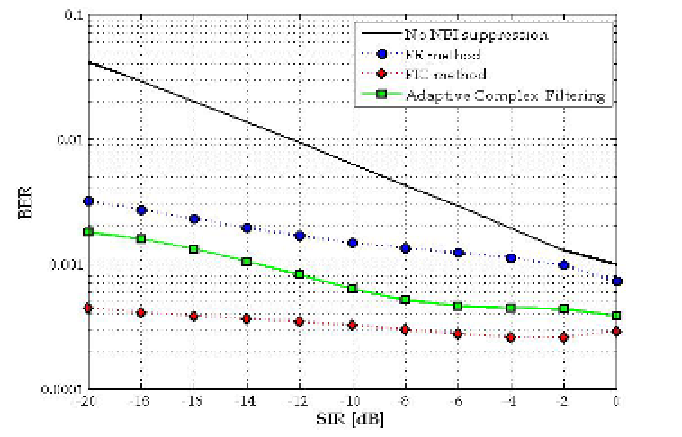Image Processing Reference
In-Depth Information
(Iliev et al, 2009). The multipath energy can be captured efficiently when the OFDM
(Orthogonal Frequency-Division Multiplexing) technique is used to modulate the
information in each sub-band. Unlike more traditional OFDM systems, the MB-OFDM
symbols are interleaved over different sub-bands across both time and frequency. Multiple
access of multi-band UWB is enabled by the use of suitably-designed frequency-hopping
sequences over the set of sub-bands.
In contrast to conventional MIMO OFDM systems, the performance of MIMO MB-OFDM
UWB systems does not depend on the temporal correlation of the propagation channel.
However, due to their relatively low transmission power, such systems are very sensitive to
NBI. Because of the spectral leakage effect caused by DFT demodulation at the OFDM
receiver, many subcarriers near the interference frequency suffer from serious Signal-to-
Interference Ratio (SIR) degradation, which can adversely affect or even block
communications (Giorgetti et al, 2005).
In comparison with the wideband information signal, the interference occupies a much
narrower frequency band but has a higher-power spectral density (Park et al, 2004). On the
other hand, the wideband signal usually has autocorrelation properties quite similar to
those of AWGN (Adaptive Wide Gaussian Noise), so filtering in the frequency domain is
possible. The c
omplex
DSP technique for suppressing NBI by the use of adaptive complex
narrowband filtering, which is an optimal solution offering a good balance between
computational complexity and interference suppression efficiency, is put forward in (Iliev et
al, 2010). The method is compared experimentally with two other often-used algorithms
Frequency Excision (FE) (Juang et al, 2004) and Frequency Identification and Cancellation
(FIC) (Baccareli et al, 2002) for the identification and suppression of complex NBI in
different types of IEEE UWB channels.
A number of simulations relative to complex baseband presentation are performed,
estimating the Bit Error Ratio (BER) as a function of the SIR for the CM3 IEEE UWB channel
(Molish & Foerster, 2003) and some experimental results are shown in Fig. 10.
(a)


